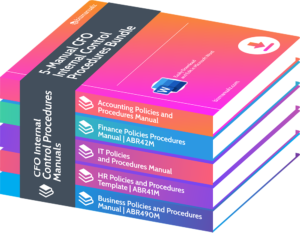What is Management’s Responsibility for Internal Controls?

Management plays a critical role in establishing and maintaining effective internal controls within an organization. Internal controls are a system of policies, procedures, and practices that are designed to safeguard an organization’s assets, ensure the accuracy of financial reporting, and compliance with laws and regulations. What is management’s responsibility for internal controls?
The Basics of Responsibility for Internal Controls
Responsibility for internal controls is a fundamental aspect of organizational governance and risk management. Here are the basics of who is responsible for internal controls in an organization:
- Board of Directors:
- The board of directors has overall responsibility for ensuring that the organization has effective internal controls in place. They oversee the management team’s efforts in this regard and hold them accountable for control deficiencies.
- Management:
- Management, including top executives and department heads, is primarily responsible for the design, implementation, and day-to-day operation of internal controls. They are accountable for the effectiveness of controls and must take corrective action when weaknesses are identified.
- Internal Audit Department:
- The internal audit department is responsible for independently evaluating the effectiveness of internal controls. They conduct audits and assessments to identify control deficiencies and provide recommendations for improvement.
- External Auditors:
- External auditors, typically a third-party audit firm, assess the organization’s internal controls as part of their audit of the financial statements. They issue an opinion on whether the financial statements are fairly presented, which includes an evaluation of internal controls over financial reporting.
- Compliance Officers and Legal Department:
- These roles are responsible for ensuring the organization complies with relevant laws and regulations. They play a critical role in designing and monitoring controls related to regulatory compliance.
- Employees:
- All employees have a role in internal controls. They are responsible for following established policies and procedures, accurately documenting their activities, and promptly reporting any control deficiencies they observe.
The basics of responsibility for internal controls involve a collaborative effort across various levels of an organization. The board sets the tone at the top, management designs and operates the controls, internal audit provides independent assessments, external auditors evaluate controls as part of their financial statement audit, and all employees play a role in implementing and following control procedures.
Effective internal controls help safeguard an organization’s assets, ensure the accuracy of financial reporting, and promote compliance with laws and regulations. Furthermore, they contribute to the overall reliability of an organization’s operations and financial information, ultimately fostering trust among stakeholders and supporting the organization’s long-term success.
Definition and Importance of Internal Control
Internal control can be defined as the set of procedures and policies aimed at safeguarding a company’s assets, maintaining accurate and reliable financial records, and ensuring compliance with applicable laws and regulations. It plays a crucial role in supporting management’s assessment of the effectiveness of a company’s internal control system.
The importance of internal control cannot be overstated. It provides stakeholders, including investors, creditors, and regulators, with confidence in the reliability of a company’s financial information. Effective internal control systems reduce the risk of financial restatements, enhance investor trust, and contribute to the overall success and sustainability of an organization.
Internal control is a complex and multifaceted concept that requires a comprehensive approach. Let’s explore the key components that make up this important system.
Key Components of Internal Control
Internal control consists of several key components that work together to ensure the accuracy and reliability of financial information. There are many different types of internal control.
Risk Assessment
This involves identifying and assessing potential risks that may impact the accuracy and reliability of financial information. It helps companies develop controls to mitigate these risks.
In the risk assessment phase, companies conduct a thorough analysis of their business processes, identifying potential vulnerabilities and areas of exposure. This includes evaluating the effectiveness of existing controls and identifying any gaps that need to be addressed. By understanding the risks inherent in their operations, companies can implement appropriate controls to minimize the likelihood of errors or fraud.
Control Environment
The control environment sets the tone for the organization, influencing the awareness of and commitment to internal controls among employees. A strong control environment fosters ethical behavior, accountability, and a commitment to internal control principles.
Creating a strong control environment starts with the tone set by top management. Leaders must demonstrate a commitment to integrity and ethical behavior, which will cascade throughout the organization. This includes establishing clear policies and procedures, promoting open communication, and providing adequate training and resources to employees.
Control Activities
Control activities are the policies and procedures that management puts in place to address identified risks. Examples include segregation of duties, proper authorization procedures, and physical controls over assets.
Control activities are the specific actions that management takes to mitigate the risks identified during the risk assessment phase. These activities can take various forms, such as implementing segregation of duties to prevent fraud, establishing proper authorization procedures to ensure accurate financial reporting, and implementing physical controls over assets to prevent theft or loss.
Information and Communication
Effective internal control systems ensure that relevant financial information is captured and communicated throughout the organization. This includes clear and accurate financial reporting, as well as timely communication of significant issues and changes in relevant laws and regulations.
Information and communication are critical components of internal control over financial reporting. Companies need to establish robust systems for capturing and processing financial data accurately. This includes implementing effective accounting systems, ensuring the accuracy and completeness of financial records, and providing timely and transparent reporting to stakeholders.
Monitoring
Continuous monitoring of internal controls is essential to ensure their effectiveness. This involves regularly assessing and testing the design and operation of controls and taking corrective action when necessary.
Monitoring is an ongoing process that involves regularly evaluating the design and effectiveness of internal controls. This includes conducting periodic internal audits, performing reconciliations, and reviewing financial statements for accuracy and compliance. By monitoring internal controls, companies can identify weaknesses or deficiencies and take corrective action to strengthen their control environment.
Understanding the key components of internal control over financial reporting is crucial for organizations to maintain the accuracy and reliability of their financial information. By implementing effective internal control systems, companies can enhance stakeholder confidence, reduce the risk of financial restatements, and contribute to the long-term success and sustainability of their operations.
Management’s Responsibility for Internal Controls

Internal control plays a crucial role in enhancing the reliability of financial reporting and preventing and detecting financial fraud. Financial reporting is not just about presenting numbers; it is about providing accurate and reliable information that stakeholders can trust.
This is where an effective internal control systems come into play. These systems are designed to ensure that financial statements are prepared in accordance with applicable accounting standards and are free from material misstatement.
But how do internal controls enhance the reliability of financial reporting? It starts with the proper recording, classification, and summarization of transactions. Internal controls help ensure that every financial transaction is accurately recorded and classified in the financial statements. This means that all revenue, expenses, assets, and liabilities are properly accounted for, leaving no room for errors or omissions.
Moreover, internal controls provide a basis for assessing the accuracy and completeness of financial information. By implementing controls that require regular reconciliations, reviews, and approvals, management can have confidence in the integrity of the financial data. This enables them to make informed decisions and fulfill their fiduciary responsibilities to shareholders, investors, and creditors.
Management’s responsibilities for internal controls include the following:
- Setting the Tone at the Top: Management, particularly top executives and the board of directors, must establish a culture of ethical behavior and compliance with policies and procedures. They set the example for the rest of the organization.
- Risk Assessment: Management is responsible for identifying and assessing risks to the organization’s objectives. This includes financial, operational, and compliance risks. Understanding these risks is crucial for designing appropriate controls.
- Control Environment: Management should create a positive control environment. This involves promoting a culture of internal control and ensuring that employees at all levels understand the importance of following control procedures.
- Control Activities: Management is responsible for implementing control activities to mitigate identified risks. This involves developing and enforcing policies, procedures, and processes that address those risks.
- Information and Communication: Management should ensure that relevant information is communicated throughout the organization. This includes ensuring that employees have access to the necessary information to perform their roles effectively and understand their responsibility for internal controls.
- Monitoring: Regular monitoring and assessment of the effectiveness of internal controls are essential. Management should establish mechanisms for ongoing control monitoring and evaluation, which may include internal audits or self-assessment processes.
- Financial Reporting: Management is responsible for ensuring the accuracy and completeness of financial statements. They must certify that financial reporting complies with relevant accounting standards and that any material weaknesses or significant deficiencies in internal controls are disclosed.
- Compliance with Laws and Regulations: Management must ensure that the organization complies with all applicable laws and regulations. This involves understanding the regulatory environment and implementing controls to address compliance requirements.
- Safeguarding Assets: Management is responsible for protecting the organization’s assets from loss, theft, or misuse. This includes implementing controls over physical and financial assets.
- Response to Issues: When internal control deficiencies are identified, management must respond promptly and take corrective action. They should investigate the root causes and implement measures to prevent the issues from recurring.
- Documentation: Proper documentation of control procedures, policies, and assessments is essential. Management should maintain records of control activities and any changes made to the internal control system.
- Reporting to Stakeholders: Management is responsible for providing information about the effectiveness of internal controls to relevant stakeholders, including shareholders, regulators, and auditors.
Preventing and Detecting Financial Fraud
Financial fraud is a significant concern for businesses of all sizes. It can lead to substantial financial losses, reputational damage, and even legal consequences. Internal control systems are designed to prevent and detect financial fraud, providing companies with a strong line of defense against fraudulent activities.
One way internal controls help prevent financial fraud is by promoting transparency and accountability within the organization. By implementing controls that require proper documentation, authorization, and segregation of duties, companies can establish a control environment that discourages fraudulent behavior.
For example, a company may implement a control that requires two individuals to review and approve any significant financial transaction. This ensures that no single person has the authority to manipulate financial data for personal gain. By separating duties and establishing checks and balances, the risk of fraud is significantly reduced.
Internal controls also play a crucial role in detecting financial fraud. Regular monitoring and testing of controls can help identify potential instances of fraud and enable prompt action to be taken. For instance, if a control is designed to flag any unusual or suspicious transactions, management can investigate further to determine if fraud has occurred.
Furthermore, internal controls provide an opportunity for employees to report any unethical or fraudulent activities without fear of retaliation. Whistleblower hotlines and reporting mechanisms are often part of an effective internal control system, ensuring that employees have a safe and confidential channel to raise concerns.
Internal control systems are essential for enhancing the reliability of financial reporting and preventing and detecting financial fraud. By ensuring the accuracy and completeness of financial information and promoting transparency and accountability, these systems provide stakeholders with the confidence they need to make informed decisions.
Establishing Effective Internal Control Systems
Establishing effective internal control systems requires careful planning, implementation, and ongoing maintenance.
Steps to Implement Internal Control 
The implementation of internal control involves several key steps:
- Identify Risks: Conduct a risk assessment to identify potential risks that may impact the accuracy and reliability of financial information.
- Design Controls: Develop controls that address the identified risks, taking into account the organization’s specific circumstances and regulatory requirements.
- Implement Controls: Put the designed controls into operation, ensuring that employees understand their roles and responsibilities and are trained on the control procedures.
- Monitor Controls: Continuously monitor the effectiveness of the internal control system through regular assessments, testing, and monitoring of control activities.
- Take Corrective Action: Promptly address any identified deficiencies in the internal control system, taking corrective action to strengthen controls and mitigate risks.
Best Practices for Maintaining Internal Control Systems
Maintaining effective internal control systems requires ongoing effort and attention. Some best practices include:
- Regular Review: Regularly review and update control procedures, considering changes in the business environment and regulations.
- Employee Training: Provide regular training to employees on internal control procedures, emphasizing their roles and responsibilities in maintaining effective controls.
- Internal Audits: Conduct periodic internal audits to assess the effectiveness of internal controls and identify areas for improvement.
- Management Support: Foster a culture of accountability and support from top management, emphasizing the importance of internal control and compliance with policies and procedures.
- Continuous Improvement: Continuously seek ways to improve internal control systems, leveraging new technologies and industry best practices.
Regulatory Requirements and Standards for Internal Control
Regulatory requirements and standards play a significant role in shaping internal control practices.
The Sarbanes-Oxley Act and Internal Control
The Sarbanes-Oxley Act (SOX) was enacted in response to corporate accounting scandals. It requires companies to establish and maintain effective internal control systems over financial reporting, and it introduced significant regulatory requirements.
SOX mandates that management assess the effectiveness of internal control over financial reporting and provide an annual report to external auditors. It also requires external auditors to attest to management’s assessment of internal control effectiveness.
Role of External Auditors in Assessing Internal Control
External auditors play a critical role in assessing the effectiveness of internal control over financial reporting. They evaluate the design and operating effectiveness of controls, test controls to ensure they are operating as intended, and identify any deficiencies or material weaknesses in the internal control system. Their assessment provides additional assurance to stakeholders regarding the reliability of financial reporting.
Challenges and Limitations of Management’s Responsibility for Internal Control 
While Management’s Responsibility for Internal Controls are essential, it is important to acknowledge that it has its challenges and limitations.
Common Issues in Implementing Internal Control Systems
Implementing effective internal control systems can be challenging. Some common issues include:
- Resource Constraints: Management may face resource constraints in terms of budget, expertise, or staff availability, making it difficult to design and implement robust controls.
- Human Error: Even with effective controls in place, human error can still occur, resulting in potential errors or misstatements in financial reporting.
- Complexity: As companies grow and become more complex, internal control systems need to adapt accordingly. Ensuring controls remain effective and efficient can be a challenge for management.
Overcoming Limitations and Strengthening Internal Control
While internal control has its limitations, there are steps companies can take to overcome these challenges and strengthen their internal control systems.
- Risk Assessment: Regularly assess and update risk assessments to identify emerging risks and ensure controls address these risks.
- Continuous Monitoring: Implement continuous monitoring practices, such as data analytics, to detect anomalies and potential control deficiencies more efficiently.
- Investing in Technology: Leverage technology solutions to automate control activities, improve monitoring capabilities, and enhance the overall effectiveness of internal control systems.
Management’s Responsibility for Internal Controls
Management’s responsibility for internal controls encompasses establishing a strong control environment, assessing and mitigating risks, and ensuring compliance with laws and regulations. It involves ongoing monitoring and assessment of controls and the promotion of a culture of ethical behavior and accountability throughout the organization. Effective internal controls not only protect the organization but also enhance its overall governance and performance.
Internal control is a critical component of sound corporate governance. It ensures the accuracy and reliability of financial information, prevents and detects financial fraud, and helps organizations comply with regulatory requirements. By implementing effective internal control systems, companies can enhance the reliability of their financial reporting and provide stakeholders with confidence in their financial information.
















Leave a Reply